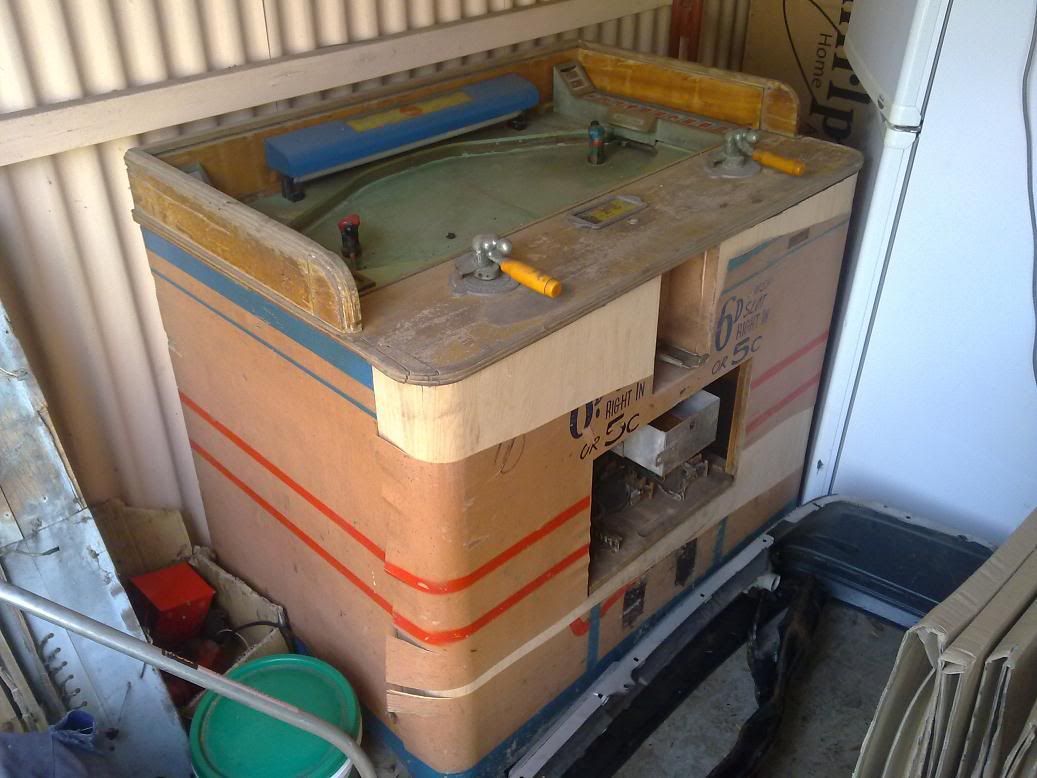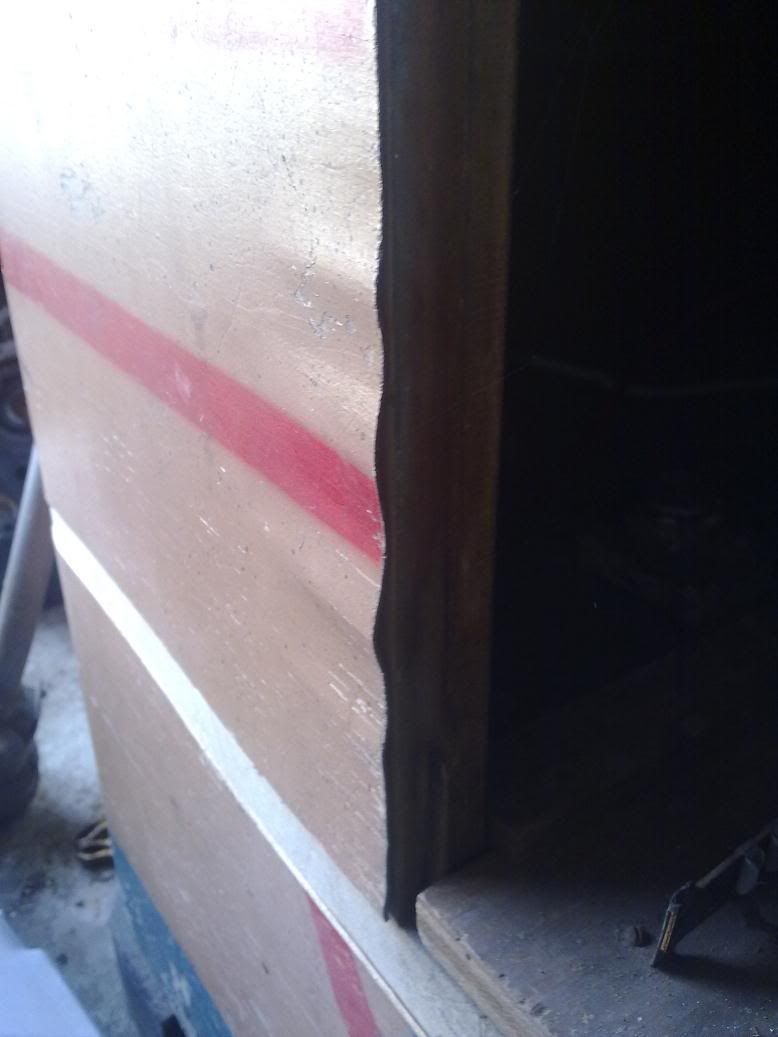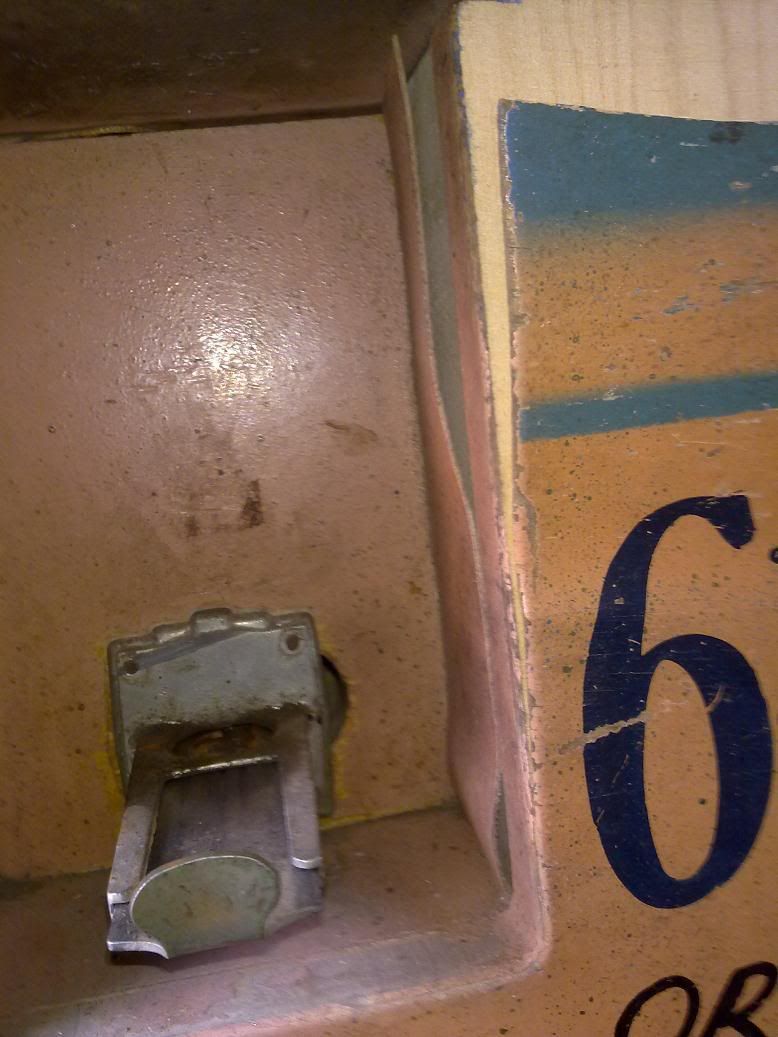 Thanks: 0
Thanks: 0
 Likes: 0
Likes: 0
 Needs Pictures: 0
Needs Pictures: 0
 Picture(s) thanks: 0
Picture(s) thanks: 0
Results 1 to 9 of 9
-
15th September 2010, 02:10 PM #1
 Novice
Novice











- Join Date
- Sep 2010
- Location
- Adelaide, SA
- Posts
- 16
 Hi! My First Post and Question #1: Veneer Repair?
Hi! My First Post and Question #1: Veneer Repair?
Hello,
I'll start by saying my history of woodworking isn't very extensive, I've been an arcade technician and now I'm an apprentice Mechanic with arcade games as a hobby..
Which is what brings me here,
I dont know if it's a common story or not, but I'm restoring some old arcade machines which have some pretty ratty looking wood work and I'm here for help on how to make them new again
The one I'm concentrating on now is a 1946 Chicago Coin "Goalee" hockey game.
The veneer is pretty badly peeling off, but I think I do have all of it, Just not necessarily attached to the machine.
I think it has come away due to the machine being kept in the heat of a corrigated iron shed for 20 odd years, there doesnt appear to be much (if any) typical water damage, and both the back of the veneer and the wood underneath seem to be very clean with not even the old glue visible at all.
What's the best way to tackle this? I've read of methods using wet carpenters glue, dry carpenters glue with heat, and contact adhesive, but I dont know which would have best results in this case as there is peeling AND veneer distortion at the ends.. also I have no Idea how the paint will react to heat, I want to keep the original paint as much as possible.
What do you reckon?





I just realised I forgot to photograph the door panel, but it's just a flat rectangle in much the same condition, I'm sure you can use your imagination:P
I'm hoping to end up with something along the lines of this:

What do you reckon I should do first?
Regards,
James
-
15th September 2010 02:10 PM # ADSGoogle Adsense Advertisement
- Join Date
- Always
- Location
- Advertising world
- Posts
- Many
-
15th September 2010, 09:18 PM #2
 GOLD MEMBER
GOLD MEMBER











- Join Date
- May 2003
- Location
- Central Coast, NSW
- Posts
- 3,330

Here's what I'd do. I'm assuming a few things here - mainly that you are wanting to protect the existing paintwork and finish - as I assume the object is of greater value if it is 'original'. I'm also assuming the majority of the veneer is stuck on reasonably firmly and you're only wanting to re-stick the bits that have come loose.
First, I'd attend to the lifting edges. The 3 bits that have come off completely I'd leave aside for the moment.
I'd apply masking tape to the outside of the existing veneers. This is to protect it from spilt or squeezed out glue. Test first to make sure the tape does not lift off the old paint. Be liberal with the masking tape - cover every bit which could possibly get glue on it, as lots of glue will squeeze out when the pressure goes on. Sometimes furniture wax will do the same job, experiment first and make sure whatever you use you can get off without damage.
Then I'd get a syringe and needle. I'd fill it up with aquadhere or some other good quality pva glue. Use the syringe to place the glue behind the veneer where it is peeling. Get it as far behind as you can, using a spatula to spread it out if necessary. The key thing here I think is to use a glue that is not sticky until it dries. That means you have some chance of keeping it neat. That rules out contact glue.
After the glue is spread, you have about 10 minutes working time. Apply a single strip of masking tape vertically along the lifting edge. The intention here is to hold the frayed, splitting edges together neatly through the next steps.
Then I'd get some bending ply or similar, cut to about the size of the front of the machine. I'd line it with plastic so the pva glue wont stick to it. Then I'd warp it around the front of the machine, such that it presses the loose bits down, smoothly all round. You need a fair bit of pressure but not so much that you crush the masking tape against the surface, which will make it impossible to remove without damage. Hold it in place with a bunch of tie-downs (as used on roof racks) wrapped right around the machine. Leave it for a few hours.
Then I'd attend to the 3 loose bits. Simliar method. Apply glue behind. Hold them in place with masking tape, and use the same pressing system.
After the glue is dry, remove the masking tape very, very carefully.
My main worry would be about the glue spoiling the finish. An alternate strategy may be to assemble, fix the pressing system, tighten, then immediately undo and wipe away any excess glue, then refit and retighten.
The front door panel is easy, just a home made caul press consisting of several sheets of mdf and home made cauls made of timber and bolts, like this https://www.woodworkforums.com/f40/ve...orking-116353/ (scroll down to the last post in thread).
The bits coming loose inside the coin slot area I'd do much the same way, but pressing outwards.
I think the veneer distortion will sort itself out when the pressure and moisture from the glue go on.
Main thing is to experiment first, on bits where it cant be seen, to make sure nothing you are doing is going to be destructive.
Hope this helps. Its a tough one.
Arron
-
15th September 2010, 09:51 PM #3
 Novice
Novice











- Join Date
- Sep 2010
- Location
- Adelaide, SA
- Posts
- 16

Thanks for the reply!
everything sounds good except I think once it's pressed on there at all the masking tape will stick too much to the paint like you said.. I will check it out though.
Also, what's bending ply? I can imagine its bendable plywood, but I dont know exactly what I'm looking for.
Thanks again!
James
-
15th September 2010, 10:59 PM #4

STEP AWAY FROM THE GLUE BOTTLE.
***DO NOT*** USE PVA GLUE ON AN ANTIQUE, GOD-DANG-IT!!!!!!!!!
If you are trying to keep it original and retain its historical value DO NOT - I repeat DO NOT use PVA glue. PVA glue to a wooden antique is like tuning a piano with a chainsaw or fixing a 300 year old family bible with sticky tape and staples.
Veneer used to be glued with hide glue. Hide glue should be the first glue you reach for in restoring any old woodwork items, as it has many points in its favour:
It's what was used originally.
It is quite strong, except when exposed to lots of heat/humidity.
It is easily repairable.
It sticks to itself without any sanding or other preparation required.
Most importantly - it is reversible. If you make a mess, you can remove it without sanding off half the timber.
You can also make jokes about it being made from "the one that came last at the 3.30 at Randwick" to shock visiting vegetarians, but this is just an added thrill and not related to its main qualities.
http://norsewoodsmith.com/content/ha...essons-learned
http://www.highlandwoodworking.com/w...hhideglue.aspx
http://www.popularwoodworking.com/ar...ool_Veneering/
Hide glue is available from the Ubeaut guy who runs these forums.
-
15th September 2010, 11:44 PM #5
 GOLD MEMBER
GOLD MEMBER











- Join Date
- May 2003
- Location
- Central Coast, NSW
- Posts
- 3,330

OK, but can you be sure the original was made with hide glue. It sounds a bit recent to be using hide glue in an industrial setting.
Arron
-
16th September 2010, 11:49 AM #6
 Novice
Novice











- Join Date
- Sep 2010
- Location
- Adelaide, SA
- Posts
- 16

Lol alright, those do sound like some good qualities, and the fact that there is no trace of any pva anywhere on the machine combined with the fact that half the veneer came off due to heat and probably humidity based on the surface rust on some metal parts kindof supports the idea that hide glue may have been used..
I'm guessing I cant just buy hide glue from Mitre10? Whats the name of the guy who runs these forums?
Most importantly, how do I use it?
Cheers!
James
Edit:
I read through those links and I have some understanding of how to use it now.
Not having to clamp it sounds good, but I'm not really sure how I'd keep it hot out in the shed.. all I have is our kitchen stove..
I'm also a little worried about how easily the warped veneer will flatten out.. I really think it needs to be softened somehow first..
-
17th September 2010, 11:45 PM #7
 Novice
Novice











- Join Date
- Sep 2010
- Location
- Adelaide, SA
- Posts
- 16

I've started collecting things, I've ordered the hide glue and I bought an old laboratory gas stove and a cooking thermometer off ebay.
What kind of brush do I need for applying the glue?
I'll probably make a veneer hammer unless someone here happens to have an unwanted one, or knows where I can buy one?
-
18th September 2010, 12:45 AM #8

If you want to test to see if it was done with hide glue originally, the steam from a kettle should soften any hide glue left (it'll go sticky, then set again when it cools down).
Hide glue didn't really get replaced by synthetics until after World War II, so there is a good chance it was made with it.
-
18th September 2010, 11:45 AM #9
 Novice
Novice











- Join Date
- Sep 2010
- Location
- Adelaide, SA
- Posts
- 16

I cant actually see any original glue at all.. where the parts have come apart the wood is clean.
I dont actually mind if the original glue is used, I dont think amusement machine collectors are as particular as furniture experts are, but after reading everything I'm going to use hide glue anyway as it seems like the best choice.
Similar Threads
-
Decking Project - Attaching Bearer to Brick Veneer and Fence Post
By marvel25 in forum WOODWORK - GENERALReplies: 1Last Post: 9th April 2009, 10:48 AM -
Restoration,, repair finishing question
By Grahame Collins in forum FINISHINGReplies: 3Last Post: 20th February 2008, 11:54 PM -
Neck repair question
By Sebastiaan56 in forum MUSICAL INSTRUMENTSReplies: 1Last Post: 20th October 2007, 11:36 AM -
'Thick' Veneer Question
By dazzler in forum WOODWORK - GENERALReplies: 8Last Post: 2nd September 2006, 11:38 PM




 Reply With Quote
Reply With Quote
